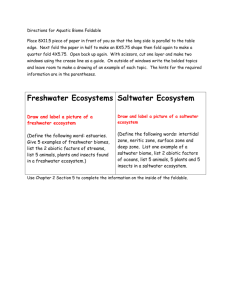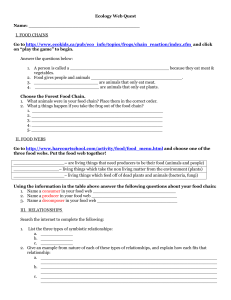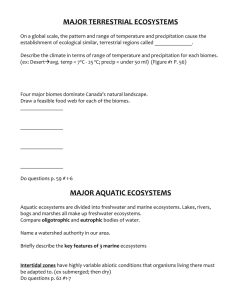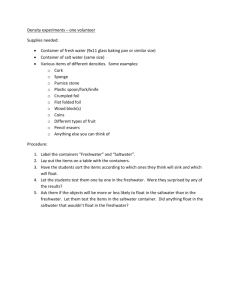File
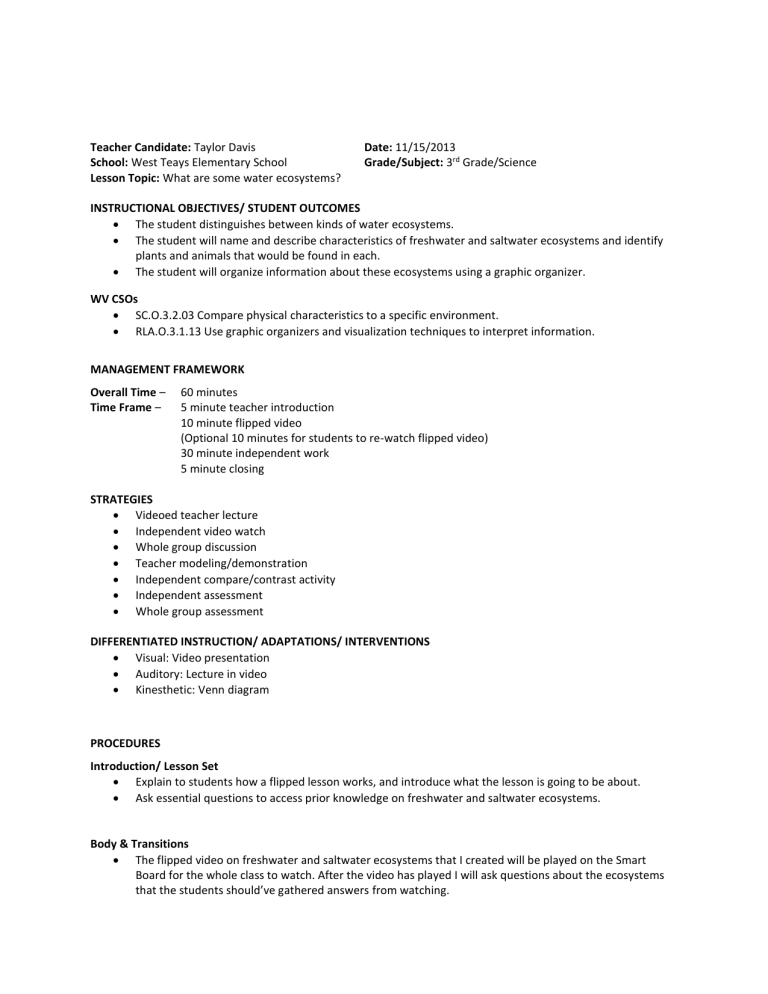
Teacher Candidate: Taylor Davis
School: West Teays Elementary School
Lesson Topic: What are some water ecosystems?
Date: 11/15/2013
Grade/Subject: 3 rd Grade/Science
INSTRUCTIONAL OBJECTIVES/ STUDENT OUTCOMES
The student distinguishes between kinds of water ecosystems.
The student will name and describe characteristics of freshwater and saltwater ecosystems and identify plants and animals that would be found in each.
The student will organize information about these ecosystems using a graphic organizer.
WV CSOs
SC.O.3.2.03 Compare physical characteristics to a specific environment.
RLA.O.3.1.13 Use graphic organizers and visualization techniques to interpret information.
MANAGEMENT FRAMEWORK
Overall Time – 60 minutes
Time Frame – 5 minute teacher introduction
10 minute flipped video
(Optional 10 minutes for students to re-watch flipped video)
30 minute independent work
5 minute closing
STRATEGIES
Videoed teacher lecture
Independent video watch
Whole group discussion
Teacher modeling/demonstration
Independent compare/contrast activity
Independent assessment
Whole group assessment
DIFFERENTIATED INSTRUCTION/ ADAPTATIONS/ INTERVENTIONS
Visual: Video presentation
Auditory: Lecture in video
Kinesthetic: Venn diagram
PROCEDURES
Introduction/ Lesson Set
Explain to students how a flipped lesson works, and introduce what the lesson is going to be about.
Ask essential questions to access prior knowledge on freshwater and saltwater ecosystems.
Body & Transitions
The flipped video on freshwater and saltwater ecosystems that I created will be played on the Smart
Board for the whole class to watch. After the video has played I will ask questions about the ecosystems that the students should’ve gathered answers from watching.
o What classifies a freshwater ecosystem? o What are some examples of freshwater ecosystems? o How are freshwater ecosystems formed? o What kinds of plants and animal would you find around a freshwater ecosystem? o What classifies a saltwater ecosystem? o What are bodies of water are saltwater ecosystems? o Are oceans the only saltwater ecosystems? o What kinds of plants and animals could you find in a saltwater ecosystem?
If the students’ understanding seems vague, I will replay the video for them. If only a few people want to re-watch the video they can watch it independently on the six computers provided in the classroom.
Students also have access to the mobile lab that I reserved for them this day. I will probably have them all watch the video individually on their computers.
The students will be given a Venn diagram to complete independently. This graphic organizer will help them sort out the similarities and differences between freshwater and saltwater ecosystems.
The students will also complete their Science workbook page 29A.
Closure
Students will be shown several pictures of freshwater and saltwater ecosystems displayed on the Elmo.
They will have to determine as a class which ecosystem each picture is, along with why they think so.
Students will be able to come up to the world map and the U.S.A. map to depict where they could find freshwater and saltwater ecosystems.
ASSESSMENT
Diagnostic:
Students will be asked essential questions before and after flipped video (objective 1, 2). (listed in procedures)
Formative:
Understanding will be assessed through teacher led discussion and student responses to scaffold questions throughout the lesson.
Students will be assessed on their understanding of water ecosystems by how well they interpreted the similarities and differences by characterizing description, animals, and plants for freshwater and saltwater ecosystems using their Venn diagram (objectives 1, 2, 3).
Summative:
Students will be assessed during the end of the lesson when I ask the class questions and they respond with which ecosystem I am referring to (objective 1).
Students will be assessed on their Science workbook page 29A grade. (objectives 1, 2).
MATERIALS
Elmo
YouTube and teacher password
Flash drive
Mobile lab
Several pictures of freshwater and saltwater ecosystems
Teacher manual of science textbook
List of essential questions
World Map
22 copies of Water Ecosystems Venn diagram (See Attachments)
22 copies of Science Workbook page 29A Lesson 4 Review (See Attachments)
EXTENTED ACTIVITIES
If Student Finishes Early
If student finishes early they can write a story on the back of the workbook page about a freshwater or saltwater ecosystem.
If Lesson Finishes Early
If lesson finishes early we will go over science workbook page in class.
If Technology Fails
If technology fails I will pass around the photos of the water ecosystems so students can see them, instead of projecting them on the Elmo.
If internet fails, I will have my flash drive with the flipped video on it to use on the teacher’s laptop.


